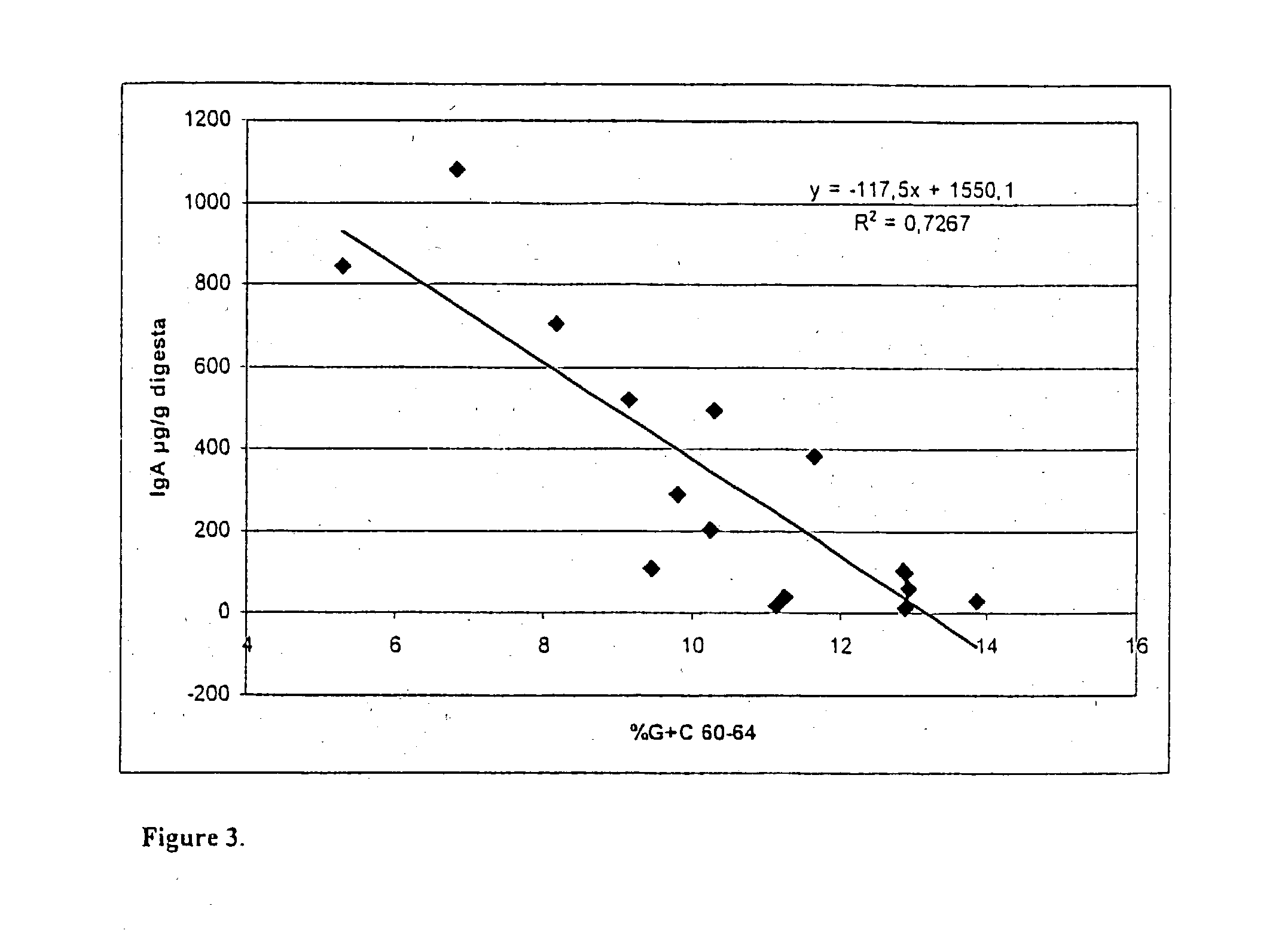Stimulation of the immune system with polydextrose
a technology of immune system and polydextrose, which is applied in the direction of accessory food factors, animal feeding stuff, non-active ingredients of pharmaceuticals, etc., can solve the problems of unfavorable growth of potentially pathogenic species, no significant laxative effect, and high risk of colon cancer, so as to improve the health condition of mammalian gut. , the effect of strengthening and improving the health condition of the gu
- Summary
- Abstract
- Description
- Claims
- Application Information
AI Technical Summary
Benefits of technology
Problems solved by technology
Method used
Image
Examples
example 2
[0092] Four week old male Wistar rats, divided into a control group and three test groups, consisting of 12 rats in each group, were held at a controlled temperature (27.+-.2.degree. C.) and 12:12 hrs light cycle. The animals had free access to food and water. The animals were weighed once a week and their weight gain was calculated. The control group was fed four weeks with a control (basal) diet and the test group was fed four weeks with the PDX-Polyol-diet, which consisted the control (basal) diet supplemented by an immunostimulating amount of polydextrose, and polyol as described in more detail below.
[0093] Control (Basal) Diet
[0094] The control diet was the same diet as defined in Example 1.
[0095] PDX-Polyol-Diet
[0096] Litesse.RTM. (Litesse Ultra lot no V68011, produced by Danisco Cultor Americ Inc.) and lactitol (N125 / 22459, produced by Danisco Sweeteners) were added to the basal diet at a 2% (w / w) concentration of each, which was calculated on the basis of human fiber intake ...
example 3
[0108] Four week old male Wistar rats, divided into a control group and three test groups, consisting of 12 rats in each group, were held at a controlled temperature (27+2.degree. C.) and 12:12 hrs light cycle. The animals had free access to food and water. The animals were weighed once a week and their weight gain was calculated. The control group was fed four weeks with a control (basal) diet and the test group was fed four weeks with the PDX-Polyol-diet, which consisted the control (basal) diet supplemented by an immunostimulating amount of polydextrose, and polyol as described in more detail below.
[0109] Control (Basal) Diet and PDX-Polyol-Diet
[0110] The control diet was the same diet as defined in Example 1. and the PDX-Polyol-diet was the same as defined in Example 2.
[0111] Sampling
[0112] The digesta samples from caecum and colon were divided into pools (3 animals per pool) for the analysis of biogenic amines. The samples were stored in -20.degree. C. until analysed. PH was me...
example 4
[0119] A batch fermentation test was performed in vitro in order to confirm the tests performed in vivo in Examples 1 to 3.
[0120] The test was based on a 24 h fermentation experiment performed with human fecal samples. Fecal samples were incubated in 24-hour batch cultures at 37.degree. C. at pH 6.9 under anaerobic conditions containing a buffer medium (mineral salt, trace elements, vitamines). The medium was supplemented with 10% extract of caecal digesta from pig. Polydextrose, polyols and their combinations were added at the level of 1% each into the test cultures.
[0121] Results
[0122] All polyols increased the relative and absolute production of butyric acid. The fermentation pattern is similar for all the polyols and for the combinations of polyols and polydextrose. The production of butyric acid was significantly increased in all of the test samples compared to the control (Table 1.)
[0123] The fermentation of polyols increases the production of butyrate, which is a source of en...
PUM
| Property | Measurement | Unit |
|---|---|---|
| Dimensionless property | aaaaa | aaaaa |
| Dimensionless property | aaaaa | aaaaa |
| Mass flow rate | aaaaa | aaaaa |
Abstract
Description
Claims
Application Information
 Login to View More
Login to View More - R&D
- Intellectual Property
- Life Sciences
- Materials
- Tech Scout
- Unparalleled Data Quality
- Higher Quality Content
- 60% Fewer Hallucinations
Browse by: Latest US Patents, China's latest patents, Technical Efficacy Thesaurus, Application Domain, Technology Topic, Popular Technical Reports.
© 2025 PatSnap. All rights reserved.Legal|Privacy policy|Modern Slavery Act Transparency Statement|Sitemap|About US| Contact US: help@patsnap.com



